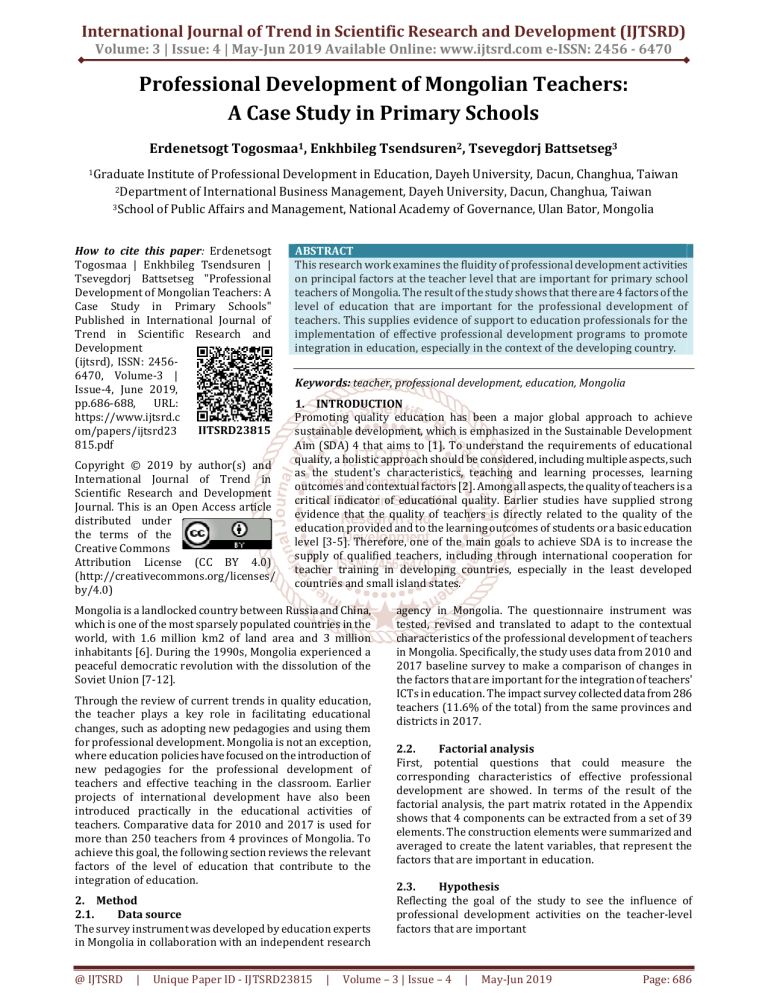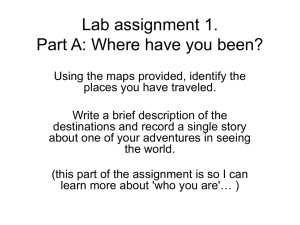
International Journal of Trend in Scientific Research and Development (IJTSRD) Volume: 3 | Issue: 4 | May-Jun 2019 Available Online: www.ijtsrd.com e-ISSN: 2456 - 6470 Professional Development of Mongolian Teachers: A Case Study in Primary Schools Erdenetsogt Togosmaa1, Enkhbileg Tsendsuren2, Tsevegdorj Battsetseg3 1Graduate Institute of Professional Development in Education, Dayeh University, Dacun, Changhua, Taiwan of International Business Management, Dayeh University, Dacun, Changhua, Taiwan 3School of Public Affairs and Management, National Academy of Governance, Ulan Bator, Mongolia 2Department How to cite this paper: Erdenetsogt Togosmaa | Enkhbileg Tsendsuren | Tsevegdorj Battsetseg "Professional Development of Mongolian Teachers: A Case Study in Primary Schools" Published in International Journal of Trend in Scientific Research and Development (ijtsrd), ISSN: 24566470, Volume-3 | Issue-4, June 2019, pp.686-688, URL: https://www.ijtsrd.c IJTSRD23815 om/papers/ijtsrd23 815.pdf Copyright © 2019 by author(s) and International Journal of Trend in Scientific Research and Development Journal. This is an Open Access article distributed under the terms of the Creative Commons Attribution License (CC BY 4.0) (http://creativecommons.org/licenses/ by/4.0) ABSTRACT This research work examines the fluidity of professional development activities on principal factors at the teacher level that are important for primary school teachers of Mongolia. The result of the study shows that there are 4 factors of the level of education that are important for the professional development of teachers. This supplies evidence of support to education professionals for the implementation of effective professional development programs to promote integration in education, especially in the context of the developing country. Keywords: teacher, professional development, education, Mongolia 1. INTRODUCTION Promoting quality education has been a major global approach to achieve sustainable development, which is emphasized in the Sustainable Development Aim (SDA) 4 that aims to [1]. To understand the requirements of educational quality, a holistic approach should be considered, including multiple aspects, such as the student's characteristics, teaching and learning processes, learning outcomes and contextual factors [2]. Among all aspects, the quality of teachers is a critical indicator of educational quality. Earlier studies have supplied strong evidence that the quality of teachers is directly related to the quality of the education provided and to the learning outcomes of students or a basic education level [3-5]. Therefore, one of the main goals to achieve SDA is to increase the supply of qualified teachers, including through international cooperation for teacher training in developing countries, especially in the least developed countries and small island states. Mongolia is a landlocked country between Russia and China, which is one of the most sparsely populated countries in the world, with 1.6 million km2 of land area and 3 million inhabitants [6]. During the 1990s, Mongolia experienced a peaceful democratic revolution with the dissolution of the Soviet Union [7-12]. Through the review of current trends in quality education, the teacher plays a key role in facilitating educational changes, such as adopting new pedagogies and using them for professional development. Mongolia is not an exception, where education policies have focused on the introduction of new pedagogies for the professional development of teachers and effective teaching in the classroom. Earlier projects of international development have also been introduced practically in the educational activities of teachers. Comparative data for 2010 and 2017 is used for more than 250 teachers from 4 provinces of Mongolia. To achieve this goal, the following section reviews the relevant factors of the level of education that contribute to the integration of education. 2. Method 2.1. Data source The survey instrument was developed by education experts in Mongolia in collaboration with an independent research @ IJTSRD | Unique Paper ID - IJTSRD23815 | agency in Mongolia. The questionnaire instrument was tested, revised and translated to adapt to the contextual characteristics of the professional development of teachers in Mongolia. Specifically, the study uses data from 2010 and 2017 baseline survey to make a comparison of changes in the factors that are important for the integration of teachers' ICTs in education. The impact survey collected data from 286 teachers (11.6% of the total) from the same provinces and districts in 2017. 2.2. Factorial analysis First, potential questions that could measure the corresponding characteristics of effective professional development are showed. In terms of the result of the factorial analysis, the part matrix rotated in the Appendix shows that 4 components can be extracted from a set of 39 elements. The construction elements were summarized and averaged to create the latent variables, that represent the factors that are important in education. 2.3. Hypothesis Reflecting the goal of the study to see the influence of professional development activities on the teacher-level factors that are important Volume – 3 | Issue – 4 | May-Jun 2019 Page: 686 International Journal of Trend in Scientific Research and Development (IJTSRD) @ www.ijtsrd.com eISSN: 2456-6470 H 1 The belief of teachers about professional competence in the educational use of ICT increased between 2010 and 2017 H 2 Teachers' belief of the collaboration of teachers in the use of ICT in education increased between 2010 and 2017 H 3 Teachers' belief of progress towards student-centered education increased between 2010 and 2017 H 4 Teachers' belief of the benefits of using ICT increased between 2010 and 2017. 2.4. Test The test of independent samples is used to determine if there is a difference between the means of two separate groups in a continuous dependent variable. In this study context, a test is used to detect if there are differences in the characteristics perceived by active professional development teachers before and after the project intervention. The test of independent samples tests the null hypothesis (H0) and the alternative hypothesis (H1), as shown below. H0: µ1 =µ2 (means of 2 groups are equal) H1: µ1 ,µ2 (means of 2 groups are not equal) 3. Results 3.1. Design analysis The descriptive statistics were first performed to obtain an overview of the differences in the latent variables between 2010 and 2017. These latent variables are the teacher-level factors that are important for education. Based on Table 1, the following observations can be made: 3.2. Test Table 2 is a summary of the hypotheses that show the result that shows the significant and no significant differences in the factors of the level of education that are important for the integration in education between 2010 and 2017. 4. Discussion The results of the data analysis showed an increase in the belief of professional competence and the attitudes of the teachers who taken part in teacher training. This section discusses those factors about the bodies of literature. He also interprets these findings in the context of professional development of teachers in Mongolia, through interviews with local primary school teachers and educational experts. Teachers were aware of the needs and requirements to promote student-centered education in 2010 when the baseline survey was conducted. In fact, the survey data wrote down that teachers' perception of progress toward student-centered education marked one of the highest average scores in the baseline survey. The score remained high in the impact survey of 2017, which writes down that this was an important perception of teachers. 5. Conclusion Promoting the professional development of teachers to achieve a quality education has become more relevant than ever throughout the world, as highlighted in the SDA. The study used data from the 2010 baseline survey and data from the 2017 impact survey collected from the participants in the teacher training. The factor analysis showed seven essential factors to illustrate the effectiveness of the @ IJTSRD | Unique Paper ID - IJTSRD23815 | teacher's professional development program. Analysis of the data found that professional development activities for primary school teachers in Mongolia had positive influences on 4 faculty-level factors. In addition, since the study focused on a primary school of Mongolian teachers, it is recommended that further studies expand the scope of research to secondary school teachers to better understand the influence of professional development activities in the field of education. Reference [1] United Nations. Sustainable Development Goal 4. Available online: https://sustainabledevelopment.un.org/ sdg4 (accessed on 26 March 2018). [2] UNESCO. Education for All: The Quality Imperative; UNESCO: Paris, France, 2005. [3] Hoffer, T.B. Accountability in Education. In Handbook of the Sociology of Education; Plenum Publishers: New York, NY, USA, 2000; ISBN 9788578110796. [4] Stronge, J.H.; Ward, T.J.; Tucker, P.D.; Hindman, J.L. What is the Relationship Between Teacher Quality and Student Achievement? An Exploratory Study. J. Pers. Eval. Educ. 2007, 20, 165–184. [CrossRef] Volume – 3 | Issue – 4 | May-Jun 2019 Page: 687 International Journal of Trend in Scientific Research and Development (IJTSRD) @ www.ijtsrd.com eISSN: 2456-6470 [5] Darling-Hammond, L. Teacher Quality and Student Achievement. Educ. Policy Anal. Arch. 2000, 8, 1.[CrossRef] [6] UNDP in Mongolia. About Mongolia. Available online: http://www.mn.undp.org/content/mongolia/en/ homSe/countryinfo/ (accessed on 26 July 2015). [7] Pomfret, R. Transition and Democracy in Mongolia. Available online: https://www.adelaide.edu.au/cies/ documents/papers/9907.pdf (accessed on 27 July 2015). [8] UNDP. Formulating the Post-2015 Development Agenda. Available online: http://www.unmongolia.mn/ new/wpcontent/uploads/2014/12/Post-2015_Eng.pdf (accessed on 26 July 2015). @ IJTSRD | Unique Paper ID - IJTSRD23815 | [9] UNESCO-IBE. World Data on Education - Mongolia, VII Ed. 2010/11; UNESCO-IBE: Geneva, Switzerland, 2011. [10] MECSS. Core Curriculum 2014; Prairie View A&M University: Prairie View, TX, USA; p. 2014. [11] Government of Mongolia. Mongolia Education Master Plan 2006–2015; Ministry of Education, Culture, Science, and Sports: Ulaanbaatar, Mongolia, 2006. Available online: http://planipolis.iiep.unesco.org/upload/ Mongolia/MongoliaEducationMasterPlan20062015.pdf (accessed on 11 April 2019). [12] MECSS. Information and Communication Technology In Education Policy (2012–2016); Ministry of Education, Culture, Science, and Sports: Ulaanbaatar, Mongolia, 2012. Volume – 3 | Issue – 4 | May-Jun 2019 Page: 688

